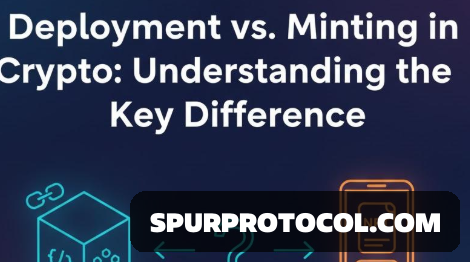Deployment Vs. Minting In Crypto: Understanding The Key Difference.
Deployment and minting may sound similar, but they mark two distinct phases in the blockchain journey. Deployment brings a project to life on-chain, while minting gives it value and existence.
Go Back

🕒 7:50 PM
📅 Nov 12, 2025
✍️ By peterAlexI
In the fast-evolving world of blockchain, it’s easy to mix up technical terms, especially when they sound similar but mean very different things. Two of the most commonly misunderstood concepts are deployment and minting. Both are crucial parts of how tokens and NFTs come to life, yet they serve completely different purposes in the crypto ecosystem.Let’s explore what each term really means and how they connect.
1. What Deployment Really Means
Deployment is the moment when a developer publishes a smart contract to the blockchain. Before deployment, a smart contract is simply a piece of code sitting on a computer. Once it’s deployed, it becomes live, recorded permanently on the blockchain, with its own unique address.
Think of deployment as launching the foundation of a building. The blueprint (code) is now part of the blockchain, and anyone can interact with it through transactions. This step defines how tokens behave, who can mint them, and what rules govern their movement.
For example, when someone creates a new token contract called “MYTOKEN” and deploys it on Ethereum, that deployment locks in the logic of how MYTOKEN will function forever, things like supply limits, transfers, and permissions.
2. What Minting Is About
Minting, on the other hand, happens after deployment. It’s the process of creating new tokens or digital assets using the deployed contract.
While deployment builds the “machine,” minting is when the machine starts producing tokens. Each time someone mints, they are generating new tokens that didn’t exist before, based on the rules written into the contract.
For cryptocurrencies, minting adds new coins into circulation. For NFTs, it’s the act of creating a unique item on the blockchain, a digital collectible, artwork, or certificate.
Using our earlier example, after MYTOKEN is deployed, the creator or users can mint actual tokens into their wallets. The contract defines who is allowed to mint and how many can ever exist.
3. The Core Difference
The simplest way to understand the difference is this:
Deployment is about putting the rules on the blockchain; minting is about using those rules to create something.
Deployment happens once, it’s the birth of the contract. Minting can happen many times, as long as the contract allows it.
One sets the stage; the other performs the play.
4. Why Understanding This Matters
Knowing the difference between deployment and minting is essential for anyone involved in crypto, developers, investors, or NFT collectors alike.
If you’re creating a token, you deploy first to define the system. If you’re acquiring a token or NFT, you’re participating in minting, the actual creation of your asset. Confusing these two steps can lead to mistakes, such as redeploying contracts unnecessarily or misunderstanding supply control.
Together, Deployment and Minting form the foundation of every token and NFT you see today, one setting the rules, and the other turning those rules into reality.
